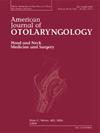人工耳蜗植入术治疗耳蜗神经缺损:系统综述
IF 1.7
4区 医学
Q2 OTORHINOLARYNGOLOGY
引用次数: 0
摘要
我们的目的是回顾现有文献,以更好地了解人工耳蜗神经缺损(CND)患者人工耳蜗植入术(CI)后的结果。数据来源pubmed, MED-LINE和谷歌Scholar。根据系统评价和荟萃分析方案的首选报告项目,我们查询了PubMed、MED-LINE和谷歌Scholar从2000年1月至2023年12月发表的关于耳蜗神经发育不全或缺陷患者人工耳蜗植入术的文章。结果在最初识别的1820篇文献中,28篇符合纳入标准,共涉及514例患者和513例人工耳蜗植入。在24项区分耳蜗神经发育不全(CNH)与发育不全(CNA)的研究中,发育不全154耳,发育不全364耳。最常见的测量结果是听觉表现类别;多项研究使用的其他结果包括听力阈值、有意义听觉整合量表、有意义言语使用量表和言语可理解度评分。术前平均CAP为0.5,术后平均CAP为3.6。术前平均听力阈值为101.3 dB, 85.5%的受试者术前听觉脑反应无反应。术后平均辅助听力阈值为42.5 dB, 4.2%的患者无反应。结论脊髓损伤对CND患儿的听力阈值和语言发育有显著的改善作用,但对深度神经发育不全或神经发育不全患儿的预后存在差异。术前应告知家庭,可能的有限结果和替代治疗的潜在好处,如听觉脑干植入。本文章由计算机程序翻译,如有差异,请以英文原文为准。
Cochlear implantation in cochlear nerve deficiency: A systematic review
Objectives
Our goal was to review the current literature to better understand outcomes following cochlear implantation (CI) in patients with cochlear nerve deficiency (CND).
Data sources
PubMed, MED-LINE, and Google Scholar.
Review methods
Following the Preferred Reporting Items for Systematic Reviews and Meta-Analyses Protocol, PubMed, MED-LINE, and Google Scholar were queried for articles published from January 2000 to December 2023 describing cochlear implantation in patients with cochlear nerve agenesis or deficiency.
Results
Of 1820 articles initially identified, 28 articles met inclusion criteria, amounting to 514 patients and 513 cochlear implantations. Among the 24 studies that differentiated between cochlear nerve hypoplasia (CNH) and aplasia (CNA), there were 154 ears with hypoplasia and 364 ears with aplasia. The most common outcome measured was Categories of Auditory Performance; other outcomes used by multiple studies included hearing threshold, Meaningful Auditory Integration Scale, Meaningful Use of Speech Scale, and Speech Intelligibility Rating. The average pre-operative CAP was 0.5, and the average post-operative CAP was 3.6. The average pre-operative hearing threshold was 101.3 dB, and 85.5 % of participants had no response on pre-operative auditory brain response. The average post-operative aided hearing threshold was 42.5 dB, with 4.2 % of patients showing no response.
Conclusions
CI in children with CND offers the potential for significant improvement in hearing threshold and speech development, but outcomes are variable in those with more profound nerve hypoplasia or aplasia. Families should be counseled pre-operatively on the possibility of limited results and the potential benefit of alternative treatments like auditory brainstem implantation.
求助全文
通过发布文献求助,成功后即可免费获取论文全文。
去求助
来源期刊

American Journal of Otolaryngology
医学-耳鼻喉科学
CiteScore
4.40
自引率
4.00%
发文量
378
审稿时长
41 days
期刊介绍:
Be fully informed about developments in otology, neurotology, audiology, rhinology, allergy, laryngology, speech science, bronchoesophagology, facial plastic surgery, and head and neck surgery. Featured sections include original contributions, grand rounds, current reviews, case reports and socioeconomics.
 求助内容:
求助内容: 应助结果提醒方式:
应助结果提醒方式:


